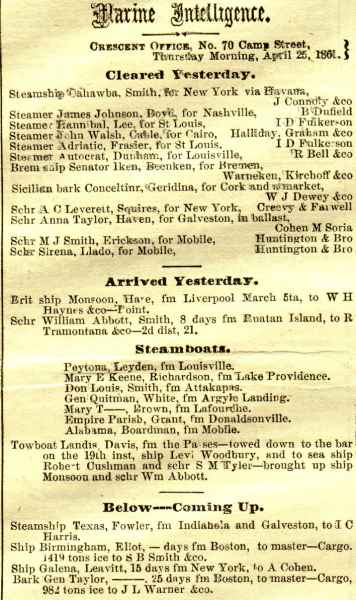

Detail from the New Orleans Daily Crescent, April 25, 1861. The River activity documented here would shortly come to an almost complete shutdown as the Union navy instituted a blockade at the mouth of the Mississippi. One year later, Admiral David Farragut landed his fleet in the New Orleans harbor and began the federal occupation of the South's most important city. At that point, the Confederacy was, more or less, doomed.The eight newspapers noted by Norman had grown to at least eleven by 1861 when this page of the Daily Crescent appeared on the city's streets. Its exposition of "elaborate commercial details" is well demonstrated by our sample page. Local newspapers of the nineteenth century are excellent sources of information about the river and the port of New Orleans, from advisories on navigational hazards to lists of cargoes on consignment from abroad to merchants of the city. The advertisements of ocean-going vessels and steamboats alike provide us not only with the names of the craft visiting the Crescent City but also with some feeling for the conditions of water transportation of that era.[Louisiana Division Newspaper Collection]
Several local newspapers over the years have been especially devoted to serving the needs of commerce and of the port. From 1822-1882, The Price Current and Commercial Intelligencer published up-to-date information on commodity prices at New Orleans along with detailed import/export data. Its lists of ships in port are probably the most informative of all the early newspapers. The Commercial Bulletin (1832-1871) also prospered, proving its own observation that, "The importance of a gazette, in such an emporium, exclusively, or almost exclusively commercial, is well understood; past experience evinces a general willingness in the community to support a paper of that description" [February 21, 1838]. Since 1921 the Daily Shipping Guide has served maritime interests in the Crescent City and the surrounding region.
 Back to River Exhibit Main Page
Back to River Exhibit Main Page
iw/we 5/1998